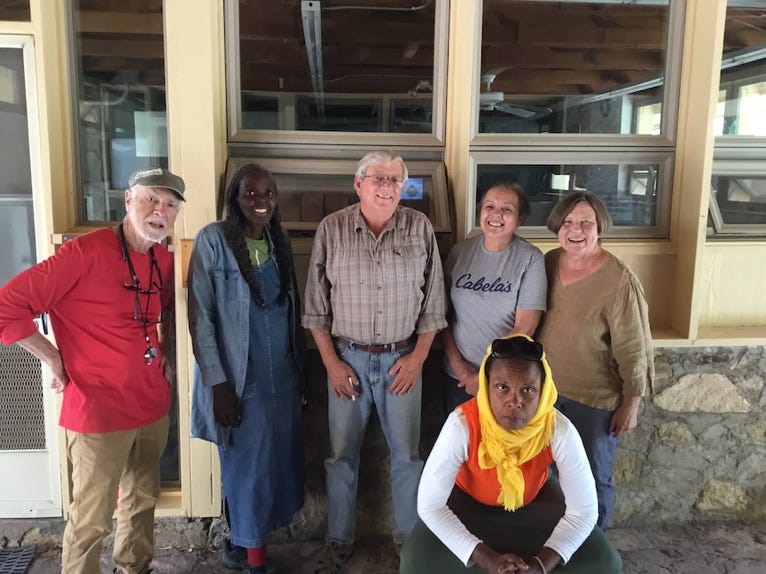Portal, AZ - Rodeo, NM
Serving The Communities Of Portal and Rodeo (www.portal-rodeo.com)
Serving The Communities Of Portal and Rodeo (www.portal-rodeo.com)

Biodiversity Of The Chiricahua Mountains
A Five Day Workshop Exploring The Amazing Biodiversity Of The Life Zones In The Chiricahua Mountains. Funded by a grant from Arizona Game & Fish.
This workshop was held at the Southwestern Research Station. It was originally intended for high school students from the Center For Academic Success in Douglas. But when the students dropped out, an e-mail was sent to the Community to participate in the 5-day workshop, which included room and board, at NO COST! Eight members of the community signed on and we had a wonderful time exploring all the life zones, looking at animals and plants, and conducting behavioral studies in the field. We also emphasized the role of Arizona Game & Fish in studying the ecology and conservation of many non-game species.
Below is a slide show, highlighting our activities. It was such a success, I wish Arizona Game & Fish would fund this program EVERY year.

Keynote Multimedia Presentations
1. Biodiversity of the Chiricahua Mountains
2. Ant Lions - In The Pits - In Holywood - In Archeology
3. The Vomeronasal Organ - A Third Chemical Sense
4. Bird Brains - The Sensory Basis of Bird Behavior
5. Hummingbird Biology & Behavior
6. Invasion Of The Booty Snatchers - Slave Making Ants
7. The Evolution Of Animal Communication
8. Of Wolves & Frogs: Conservation Programs Sponsored By Arizona Game & Fish
10. The Question Of Evolutionary Adaptations: How To Generate Scientific Hypotheses
11. Patterns Of Hummingbird Migrations (Presented by Jackie Lewis)
You Can Advance The Slides With The Right & Left Arrows, On Either Side Of The Thumbnail Images
Studies Of Animal Behavior
1. Food Selection By Mexican Jays.
We placed ball-park (shelled) peanuts on the ground for 2 flocks of Mexican jays. The jays pick them up but often drop a peanut to select another. What parameter are they looking for? When a plastic hawk decoy is placed near the peanuts, the jays stay on branches just above the food, but do not come down to feed. When we place a plastic jay decoy near the food, they come down, hop around the food for a while and then cautiously take the peanuts.
2. Competition Avoidance By Harvester Ants.
Four colonies of Pogonomyrmex whose nests are arranged in a relative square pattern are selected for study. Each colony was assigned a different color flag. The foraging routes were mapped by placing colored flags along their foraging paths. The goal was to see that the ants minimize competition by foraging in directions AWAY from each other.
3. Ant Lion Feeding And Obstacle Removal.
Each person collected an ant lion larva in the field and established it in the laboratory. When pits were constructed, we fed them harvester ants. These ants are large, have a thick exoskeleton, and a powerful sting. We observed the variety of feeding strategies used by the ant lions to subdue the prey. Some of us then placed small pebbles as the bottom of the pet. Depending on the weight of the pebble, the ant lions had a variety of strategies for removing the obstacle.
4. Color Learning By Hummingbirds.
Hummingbirds are attracted to red feeders, because they have learned to forage for nectar at red flowers. The one color hummingbirds ignore is green, since they would waste valuable time inspecting every green leaf in the forest. We set up three feeders on a clothesline: red, black, and green. Only the green feeder had sugar, the others only water. The goal was to see whether the birds would learn to forage at the green feeder.
5. Slave Raids By Polyergus topoffi.
In late afternoon, we went to Portal to watch a colony of Polyergus stage one of their famous slave raids. Hundreds (sometimes thousands) of ants “pour” out of their nest, attack a colony of Formica ants, steal the Formica pupae, bring the pupae back to their own nest and rear the pupae to be their slaves. It is one of the most exciting natural history events in the world!
6. The Vomeronasal Organ: The Third Chemical Sense.
We caught whiptail and spiny lizards, and took a close-up look at their tongues. The tongue of Yarrow’s spiny lizard is oval shaped and not forked. Bering a sit-and-wait predator on a rock, it does not extrude its tongue. Whiptail lizards run around on the ground in search of prey. Their tongues are forked (like a snake) and are extruded frequently as they move. This led to a discussion of the vomeronasal organ (called Jacobson organ in reptiles) in vertebrate animals. Do humans have one?